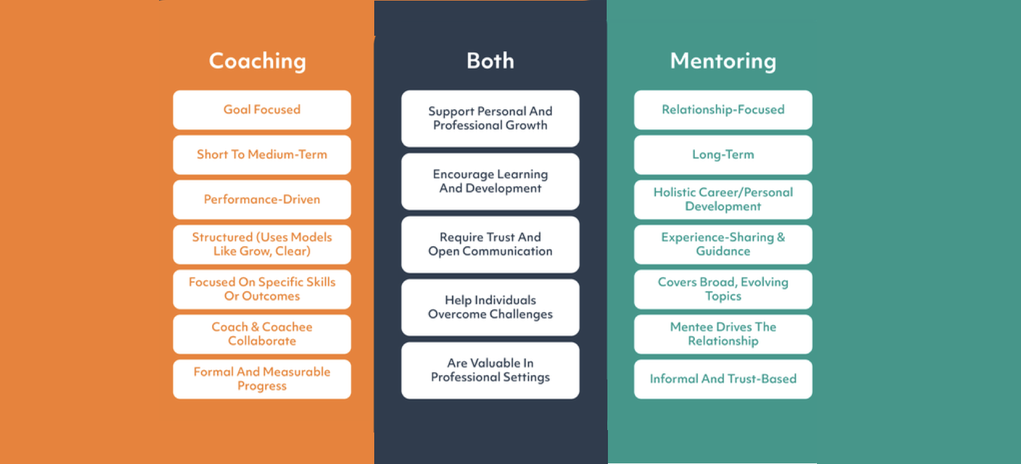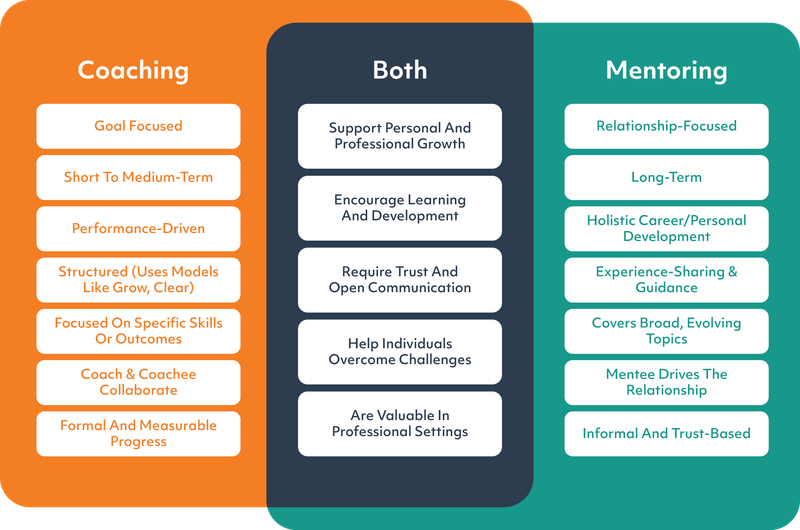The Future of Growth: Coaching, Mentoring, and the Rise of AI in Employee Success

In our rapidly changing world, employee growth and development are more crucial than ever before. Throughout this article, we will explore the need, benefits, struggles and success using examples from a large pharmaceutical company who implemented AI-augmented coaching.
Coaching and mentoring are not just about keeping employees engaged. They are about building a workforce capable of navigating challenges, taking on new responsibilities, and growing into leadership roles. Coaching and mentoring are widely recognized as essential strategies for fostering both personal and professional growth (Maxwell, 2008; Whitmore, 2009; Sinek, 2017). But the reality is that traditional coaching and mentoring models are too hard to operate at scale. They are limited by the availability of human resources; coaches and mentors can only handle so many employees at a time.
As companies grow, employees spread out geographically, and business demands become more complex, the availability of coach and mentor support declines. This is where AI can assist. AI in coaching and mentoring is not a replacement for human interaction, but rather a partner that extends the reach of traditional programs. With AI, coaching and mentoring can scale to meet the needs of many employees, not just a select few. AI provides personalized, consistent, and real-time support for both coaches and team members. When combined, human and AI coaching/mentoring ensures that each employee has the resources they need to succeed.

Figure 1 -COMPARISON OF MENTORING AND COACHING
The reason coaching and mentoring work so well is simple: both create space for personal growth through a relationship of trust and reflection. Through this coaching relationship, employees gain confidence, clarity, and a deeper understanding of their potential. This, in turn, drives performance.
Coaching and mentoring also provide an emotional benefit. They offer a safe space for individuals to reflect, express vulnerability, and overcome challenges. In high-stakes industries like life sciences and pharmaceuticals, where decision-making can directly affect public health, these personal elements of development are even more critical. Employee growth becomes not just an organizational need, but a life-or-death matter in some contexts.
Let’s talk about a real-life example.
A major pharmaceutical company approached Unboxed recognizing the need to create a culture of coaching. In their words, they needed to:
- Create a central place for performance and coaching to drive quality customer experiences
- Embed coaching activities into daily habits and workflows
- Provide coaching data to contribute to balanced performance management
- Identify skill gaps and actions to help employees grow and develop in their role
Despite knowing the clear benefits and need for coaching, this company recognized the significant strain it places on human capital. Mentors and coaches have limited hours, and each session requires deep emotional and intellectual investment. Additionally, it’s not just the mentors and coaches who suffer from the strain. Often, early-career employees, remote workers, and those in hard-to-reach areas get overlooked or placed on waitlists for these services. The administrative burden is also large. From matching mentors with mentees to tracking progress and setting up meetings, human capital departments spend time on logistics rather than on improving the quality of coaching and mentoring. Because these models are unsustainable, many employees miss out on the support they need to reach their full potential.
So, what does a realistic framework of annual coaching look like?
For one company, they chose:
- Quality Observations – Four 15-minute systematic observations per month
- Side-by-Sides – One 60-minute in person coaching session per month
- 1:1 Performance Review Conversation – One 60-minute private conversation to discuss performance and review scorecards per month
- Mid-Year/End-of-Year
- Self-Reflection – One 30-minute self-reflection on their own behaviors, actions, and interpersonal skills
- Mid-Year/End-of-Year Review – One 30-minute private discussion on performance and measurement against business impacts
- Career Growth – One 60-minute constructive dialogue focused on professional development and growth
Your company may set an entirely different cadence and short term mentoring may have a different cadence as well.
Once goals and a coaching framework are in place, the next task is systematically tracking and holding accountable the leaders and employees involved. Here’s where the right coaching/mentoring platform and AI can help. Systematically, a good coaching tool can set up reminders and goals for the tactical cadence. But what about an employees’ needs in-between formal sessions? What if the leaders who are providing coaching aren’t good at it? The results will be questionable. AI is perfectly poised to support employees in-between live sessions. AI can support leaders with reminders, but more importantly, it can help in improving writing effectiveness, suggesting actionable feedback, and in recommending follow-up tasks aligned with company/department goals. AI reduces the drain on coaches and mentors and can free them up to focus on building deep, meaningful relationships with employees.
AI can also help employees track their own progress, set goals, and reflect on their own time. It can provide consistent feedback and personalized nudges. For example, after a coaching session, AI can remind an employee of their goals and suggest resources or reflective prompts. AI can also help employees rehearse challenging conversations (such as giving feedback or handling objections) before they do it in real life. These tools allow employees to practice skills, build confidence, and ensure that they’re moving in the right direction, whether or not a human mentor is available in the moment. Consider a few examples of how AI can support coaching and mentoring:
- A new leader can practice giving feedback through an AI simulation, gaining insights before facing a real-world scenario.
- A sales representative can receive daily reminders about their personalized development goals, ensuring that they stay on track throughout the week.
- A new hire can use an AI mentor to ask questions and gain insights into company culture, compliance standards, or role expectations before connecting with a human mentor.
AI doesn’t replace the human element; it supplements it, ensuring that employees have consistent, actionable support at every stage of their development journey.
AI coaching and mentoring brings multiple benefits:
- Scalability: AI can reach hundreds or even thousands of employees without overburdening your mentors.
- Cost-effectiveness: Once set up, AI tools can operate with minimal costs and save time by handling routine tasks.
- Equity: With AI, every employee has equal access to developmental resources, ensuring that even those in remote areas or with fewer resources can grow.
- Consistency: AI ensures that the coaching and mentoring experience remains consistent for all employees, no matter when or where they access it.
- Reduced burnout: Coaches and mentors can focus on the deep work of guiding employees while AI handles the repetitive check-ins and goal tracking.
When embracing AI in employee development and coaching rhythms, there are some important ethical considerations. Data privacy, AI bias, and transparency are top priorities. AI tools must be secure and compliant, with clear opt-in systems to ensure employees understand how their data will be used. Regular audits for bias and ensuring human oversight are also key to making sure AI remains an effective and ethical partner in development.
AI-enhanced coaching and mentoring offer more than just cost savings. ROI comes in many forms: time saved by employees and mentors, increased engagement and retention, higher productivity as employees become more effective in their roles, and more equitable access to developmental resources. But it’s also important to capture qualitative ROI like the confidence gained, the insights learned, and the growth achieved through AI-guided reflection and practice. These shifts in mindset and capability are what make AI-driven coaching and mentoring truly impactful.
What is the impact of one year of consistency in coaching/mentoring?
In one year of execution, the numbers were staggering. Over 1000 hours were spent coaching (side-by-sides, manager 1:1s, and quality forms) and discussing and documenting performance. But the results were more than just the number of forms completed. Employee satisfaction improved, retention improved, and sales performance improved by nearly 50%. Leaders, through practice, improved their coaching behaviors. Overall, employees felt better acclimated to culture, strategy, compliance, and had an improved overall business acumen.
The future of coaching and mentoring lies in AI-augmented, human-focused engagements
The most effective organizations will combine human empathy and expertise with the scalability and consistency of AI. AI provides the infrastructure: the nudges, reflections, and resources. Humans provide the guidance, mentorship, and emotional connection that drive real growth. As we enter a new era of human development, AI helps to make coaching and mentoring accessible to all and ensures that employees have the tools and resources they need to succeed. But at its core, development is still human. AI has the power to amplify that human connection and accelerate employee growth in the future.
Sidebar: Top 5 Questions to Ask Before Introducing AI Coaching
- What problem am I solving—scale, equity, cost, or consistency?
- How will AI integrate with our human-led programs?
- How will we protect employee privacy and confidentiality?
- How will we measure success, both quantitatively and qualitatively?
- Who owns the ethical guardrails for AI conversations?
Suggested Resources:
Chaudhury, M. (2021). AI in employee development: The ethics of using artificial intelligence in coaching and mentoring. Journal of Business Ethics, 184(2), 339–356.
Deloitte Insights. (2020). AI, talent, and the future of work: Leveraging technology to develop human potential. Deloitte University Press.
Gartner. (2021). Top 5 AI trends in human resources for 2021.
Grant, A. M. (2014). The efficacy of coaching. International Coaching Psychology Review, 9(2), 124–144.
Hawkins, P. (2017). The coaching manual: The definitive guide to the process, principles and skills of personal coaching. FT Press.
Keller, M., & McConnell, C. (2020). Artificial intelligence in human resources: A global survey of AI adoption in HR practices. Journal of Business Research, 120, 128–140.
Maxwell, J. C. (2008). Mentoring 101: What every leader needs to know. Thomas Nelson.
Scott, K. (2017). Radical candor: Be a kick-ass boss without losing your humanity. St. Martin’s Press.
Sinek, S. (2017). Leaders eat last: Why some teams pull together and others don’t. Portfolio.
Whitmore, J. (2009). Coaching for performance: Growing human potential and purpose: The principles and practice of coaching and leadership. Nicholas Brealey Publishing.


